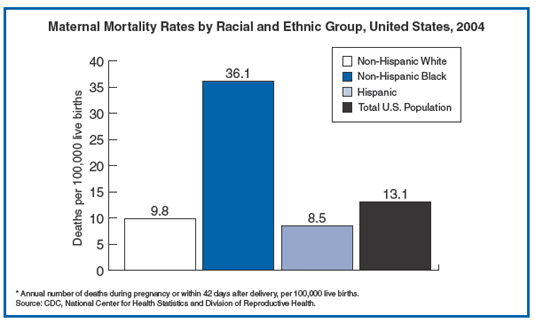 |

|
 |
 |
 |
Safe Motherhood
Promoting Health for Women Before, During, and After Pregnancy
At A Glance
2008
This document is also available in
Portable Document Format
(PDF–979K).
Learn more about
PDFs.

“The world looks to us for leadership in
demonstrating how to achieve and sustain safe motherhood.
CDC’s work in safe motherhood is truly where science meets society.”
Wanda K. Jones, DrPH
Deputy Assistant Secretary for Health (Women’s
Health)
Director, Office on Women’s Health, U.S. Public Health Service
Safeguarding the Health of Mothers
Safe motherhood begins before conception with proper nutrition and a
healthy lifestyle. It continues with appropriate prenatal care, the
prevention of complications when possible, and the early and effective
treatment of any complications. The ideal results are pregnancy at term
without unnecessary interventions, the delivery of a healthy infant, and
a healthy postpartum period in a positive environment that supports the
physical and emotional needs of the woman, infant, and family.
Addressing Maternal Mortality and Morbidity
Maternal death continues to be the international standard by which a
nation’s commitment to women’s status and their health can be evaluated. It
is the primary measure of whether women can expect to survive complications
that arise during pregnancy, delivery, and the postpartum period. In the
United States in 2004, the rate of maternal mortality was 13.1 deaths per
100,000 live births, with great disparities in many racial and ethnic
communities. The leading causes of pregnancy-related deaths in the United
States are hemorrhage, blood clots, high blood pressure, infection, stroke,
amniotic fluid in the bloodstream, and heart muscle disease.
However,
mortality is not the only indicator of women’s health. In 2001, CDC began
working with national and international groups to develop and implement
programs for safe motherhood, including those designed to prevent illness,
death, and disability among women of reproductive age.
Sustaining Progress to Prevent Deaths
In the United States, 1 to 2 women die each day of pregnancy
complications. From 1900 to 1982, deaths from pregnancy complications in the
United States declined sharply. Anti-biotics, better obstetric procedures,
and control of infections have helped to prevent many deaths over the past
century. Despite these advances, studies indicate that as many as half of
all deaths from pregnancy complications could be prevented if women had
better access to health care, received better quality care, and made
positive changes in their health and lifestyle habits. Some people believe
that maternal deaths are a rare event. However, maternal mortality rates
have not improved in recent years, and deaths continue to occur.
Racial, Ethnic, and Age Disparities
A woman’s race, ethnicity, country of birth, and age can be associated
with her risk of dying of pregnancy complications. These same factors may
affect her ability to avoid unintended pregnancy, have access to adequate
medical care, or learn and successfully practice healthy behaviors. CDC
continues to investigate these disparities and to make information available
to health care providers, scientists, and the general public to help
eliminate these disparities.

[A text
description of this chart is also available]
CDC’s Role in Safe Motherhood
CDC is committed to ensuring that all people, especially
those at greater risk for health disparities, will achieve their optimal
lifespan with the best possible quality of health in every stage of life.
With agency-wide health protection goals that support healthy people in
healthy places across all life stages, CDC is setting the agenda to enable
people to enjoy a healthy life by delaying death and the onset of illness
and disability by accelerating improvements in public health.
To better understand the burden of maternal complications
and mortality and to decrease disparities, CDC’s Division of Reproductive
Health supports national and state-based surveillance systems to monitor
trends and investigate health issues; conducts epidemiologic, behavioral,
demographic, and health services research; and works with partners to
translate research findings into health care practice, public health policy,
and health promotion strategies.
Pregnancy Mortality Surveillance System (PMSS)
CDC works with state health departments and other groups to
identify and gather information on pregnancy-related deaths. With its
partners, CDC collects data on women who died during or within 1 year of
pregnancy. Data are used to describe conditions that lead to death, identify
risk factors for pregnancy-related deaths, and identify disparities in death
rates. All states, the District of Columbia, and New York City contribute
data for this surveillance system. CDC recently used PMSS data to describe
associations between violence and pregnancy-related deaths.
Maternal Mortality Review Committees
CDC provides technical assistance and expertise to help
states establish maternal mortality review committees. CDC collaborated with
the Health Resources and Services Administration, the American College of
Obstetrics and Gynecologists, the Association of Maternal and Child Health
Programs, and representatives of several states to publish best practices
for improving maternal mortality review processes and activities. CDC is
currently working with its partners to update national and international
recommendations for conducting reviews and using data from these reviews to
improve safe motherhood programs.
Pregnancy Risk Assessment Monitoring System (PRAMS)
PRAMS provides information about women’s health and health
behaviors before, during, and immediately after pregnancy. Data are used to
develop indicators of success in improving the health of mothers and their
infants. PRAMS data also are used by state officials, researchers, and
program managers to guide decisions on maternal and child health programs,
practices, policies, and resources. In some parts of the United States,
PRAMS data have been used to describe women’s ability to accept and use
specific health recommendations, including those related to prenatal care,
folic acid use, breastfeeding, HIV testing, and smoking cessation.
PRAMS recently expanded to include 37 states, New York City,
and one tribal nation. PRAMS data represent approximately 75% of births in
the nation, and most importantly, the experiences of the women who gave
birth to these infants.

[A
text
description of this chart is also available.]
Maternal and Child Health Epidemiology Program (MCH-EPI)
This program provides expertise and support to state and local health
departments to help them conduct studies to improve public health practice
and management. In fiscal year 2007, 8 MCH epidemiologists and 8 MCH fellows
were working in public health agencies in 13 states.
Interactive Atlas of Reproductive Health
CDC publishes the Interactive Atlas of Reproductive Health, which
presents indicators of reproductive health in a clear, accessible format.
This online reference is designed to be used by professionals working in
public health and health care as well as by the general public.
The indicators include fertility, health risk factors, maternal health,
and infant health. Periodic updates allow users to compare information by
age, race, ethnicity, risk, and geographic location. The atlas is available
at
http://www.cdc.gov/reproductivehealth/GISAtlas/index.htm.
Future Directions for Safe Motherhood Programs
Preconception Health
In 2006, CDC released a report with guidelines on how health care
providers can support women’s efforts to achieve and maintain optimal health
before, during, and beyond their reproductive lives, regardless of decisions
to bear children. These guidelines are intended to help providers prevent
death, disease, and disability among their patients. The findings in this
report are based on reviews of evidence by experts in medicine and public
health. CDC is working with its partners to expand the acceptance and use of
these findings and guidelines into everyday practice and health care policy.
We also are working to identify how society, economics, genetics, geography,
and other factors influence women’s health before, during, and after their
reproductive years.
The Burden of Infertility
Safe motherhood embraces the concerns of women who have attempted to
conceive naturally without success. In 1996, CDC published its first report
on assisted reproductive technology (ART), called Assisted Reproductive
Technology Success Rates. This report provided a national overview of
outcomes at U.S. fertility clinics. CDC has published 10 ART reports over
the years, and we continue to monitor trends in the use of ART services and
maternal and infant health outcomes. CDC hopes to expand these efforts in
the future to respond to a growing demand for information on how to overcome
infertility in women and men. In 2008, CDC plans to convene a panel of
experts to discuss the public health burden of infertility on families and
communities.
Chronic Diseases and Reproductive Health
An important component of safe motherhood is improving outcomes for women
who have or will develop chronic diseases such as diabetes or heart disease
during their reproductive years. Recent PRAMS surveys have included
questions about diagnosis of diabetes during pregnancy. Women with diabetes
must take the disease into account when choosing a contraceptive method or
preparing for pregnancy. In the future, CDC plans to devote more attention
to gestational diabetes, which is a strong predictor of future type 2
diabetes in many women during and after their reproductive years. CDC also
will work with its partners to better understand genetic, metabolic, and
other factors that can lead to infertility in women and men. These data and
evidence could lead to important breakthroughs for U.S. families.
Emerging Threats and Safe Motherhood
CDC recognizes that new threats to safe motherhood have emerged in this
century. These threats include man-made and natural disasters, as well as
emerging infectious diseases. Fortunately, many CDC reproductive health
professionals have experience working in emergency settings and complex
medical situations. For example, in 2005, CDC staff helped in the aftermath
of Hurricane Katrina, when obstetric services were shut down or relocated in
some areas. In 2006, CDC staff provided scientific and other assistance in
Puerto Rico to help assess the impact of dengue fever on pregnant women. CDC
will draw on this experience to help prepare public health professionals for
the next emergency, whether it is a threat of monkeypox, anthrax exposure,
or natural disaster.
HIV Prevention and Care
CDC’s Division of Reproductive Health will continue its pioneering work
into understanding the burden of HIV infection on the reproductive lives of
women and men. These efforts will require continued support that delivers
evidence about new technologies and strategies to protect those who are not
infected. At the same time, important investments need to be made to help
people at high risk for infection and women who need to use anti-retroviral
drugs before and during their pregnancy. CDC will continue to be involved in
microbicide research and other new technologies, reviewing guidelines for
contraceptives for people using anti-retroviral drugs and evaluating
outcomes of new technologies for HIV prevention.
CDC’s Investment in the Health of Women
CDC will continue to invest resources to ensure safe motherhood for all
U.S. women and to overcome disparities in reproductive health. Ongoing
activities and research seek answers to questions about differences in
health status, risks, and outcomes related to race, ethnicity, age,
geography, and other demographic factors. CDC continues to invest in using
the behavioral sciences to understand disparities that create or provide
protection from health risks. CDC will continue to work with partners to
address urgent issues related to safe motherhood, including depression,
premature labor and delivery, teenage pregnancy, and reproductive health and
violence. We also will work to prevent negative outcomes of pregnancy,
including miscarriage, stillbirth, and the sudden, unexpected death of
infants.
|
For more information please contact
Centers for Disease Control and Prevention
National Center for Chronic Disease Prevention and Health Promotion
4770 Buford Highway NE, Mail Stop K–93, Atlanta, GA 30341-3717
Telephone: 770-488-5200 • E-mail:
cdcinfo@cdc.gov
Web: http://www.cdc.gov/reproductivehealth
|
|
Page last reviewed: February 11, 2208
Page last modified: February 11, 2008
Content source: National Center for
Chronic Disease Prevention and Health Promotion
|
 |
